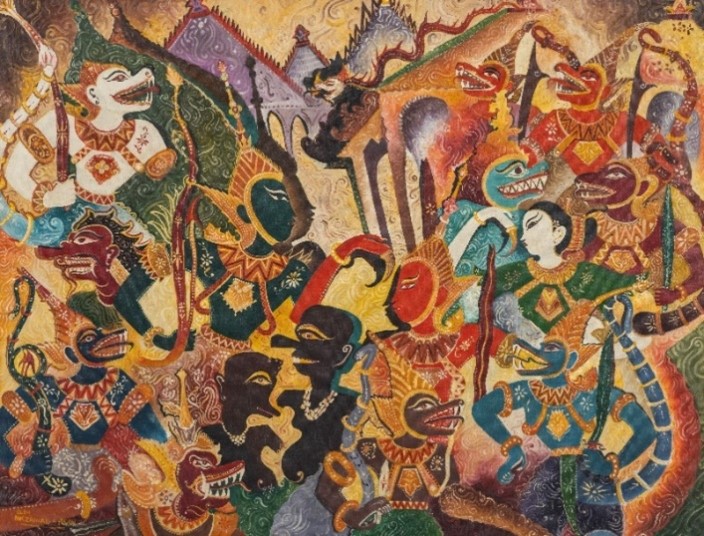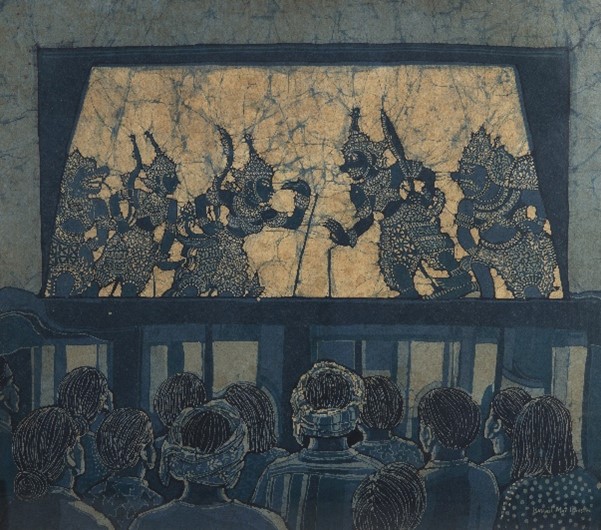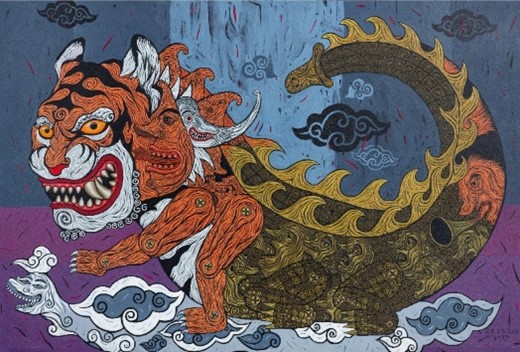




Before the advent of modern cinema and television, our society had long been accustomed to the art of shadow puppets, which remains a national treasure. The shadow puppeteer or Dalang would skilfully manipulate the shadow puppets behind a screen while narrating the story to an audience. Interestingly, this runs parallel to today’s artists too, as they use their respective techniques through drawings, sculptures, installations, and multimedia to tell their own stories. A treasure trove of stories was told, from the origin story of Hikayat Seri Rama and Pandawa Lima, which were adapted from Hindu epics to other narratives that evolved with the infusion of current highlights.
GERAK BAYANG: The Art of Storytelling exhibition revolves around the design and elements of traditional shadow puppets, which characters were then translated onto canvas. Some of the artists utilise new media methods to bring tales to life. More than 35 artists including Nik Zainal Abidin, Long Thien Shih, Ismail Mat Hussin, Masnoor Ramli Mahmud, Adeputra, Haris Abadi and Ismail Awi, invite us not only to delight in their work but also to ponder their ‘voices’. This, in turn, raises awareness to ensure the art of fellow puppeteers and shadow puppets remain alive.
INTRODUCTION
The beauty of our traditional performing arts can be witnessed in every state of Malaysia, each with its distinct and unique artistry. Among these is oral storytelling, which was practiced by our ancestors and has been passed down through many generations. In Malay culture, storytellers are known by various names such as penglipur lara, Tok Selampit, and Awang Batil each with their own unique storytelling style. As for the shadow puppet or wayang kulit performance, the storyteller is known as the Tok Dalang. It is truly remarkable how they grasp and memorize various storylines, immerse themselves in the characters, and deliver them spontaneously to the audience. This art form needs to be passed down to the next generation, and this is where the role of researchers becomes essential in documenting traditional performing arts as a heritage that must be preserved.
GERAK BAYANG: The Art of Storytelling exhibition showcases various works of art revolving around the theme of wayang kulit, including several puppets for observation and appreciation. More than 35 artists have been brought together for this exhibition, including Nik Zainal Abidin, Long Thien Shih, Shafie Hassan, Ismail Mat Hussin, Syed Thajudeen, Chang Fee Ming, Taquddin Bahro, Haris Abadi, Nik Husyaidie, and Ismail Awi. Wayang kulit in Malaysia has been significantly influenced by neighbouring countries. Wayang Kulit Kelantan (Kelantan) and Wayang Gedek (Kedah) have been influenced by Wayang Kulit Siam. Meanwhile, Wayang Purwa or Wayang Jawa (Johor) was brought by those who migrated from Java to Malay Peninsula. The uniqueness of Wayang Melayu lies in its combination of Javanese and Kelantanese elements, which were once performed in Kelantan and Terengganu. Apart from well-known original tales like Hikayat Seri Rama and Pandawa Lima, which are adaptations from the Hindu epics Ramayana and Mahabharata, modern Dalang now also present stories infused with contemporary issues. Both good and evil characters are portrayed to raise awareness and provide education, in addition to entertaining the community. Seri Rama, Siti Dewi, Hanuman, and Rawana are among the important characters in Hikayat Seri Rama. Additionally, other characters such as Pak Dogol, Wak Long, Samad, and Said are also popular in Wayang Kulit Kelantan performances. To ensure continuity, some members of the wayang kulit group have become educators in several higher education institutions such as the National Academy of Arts, Culture, and Heritage (ASWARA), Universiti Sains Malaysia (USM), and Universiti Malaysia Kelantan (UMK). However, this task requires support from various parties to provide greater encouragement to wayang kulit practitioners in continuing their efforts. In addition to visual artists who interpret wayang themes in their works, researchers and outcomes need to be disseminated more effectively for reading, viewing, reference, and discussion. This will ensure that the efforts of all parties are better understood and appreciated, aiming for the preservation of our cultural heritage.

DALANG’S SCREEN
The puppeteer, known as Dalang, skilfully manipulates the puppets with nimble fingers, making them dance from right and left in perfect sync with the storyline. The audience would watch the shadows on the screen, listening to the Dalang's varied voices along with the accompanying music, altogether creating an enchanting experience for themselves.
In the past, the wayang kulit theatre was among the places where the community gathered to unwind and relax after toiling throughout the day to earn a living. The Dalang would entertain the crowd with traditional tales, incorporating moral lessons and humour to captivate their attention, often highlighting family values. Throughout the performance, the audience would enjoy the show and move freely under the moon's soft glow. Throughout the performance, the audience would enjoy the show and move freely under the moonlight.
At the beginning and end of the show, a special puppet called the Pohon Beringin (Tree of Life or banyan tree) is used to signify the start and conclusion of the performance. The pohon beringin, which is set up by the Dalang behind the screen, contains 'life' within it, such as flora and fauna. In this exhibition, several wayang kulit characters can be observed, including Seri Rama depicted in dark green and red colours, as well as Laksamana portrayed in red and gold.
In the Dalang's Screen section, several artworks can be seen, representing the front and back of the shadow puppet theatre, as well as the richness and diversity of the characters. These artworks are produced by proficient artists such as Ismail Mat Hussin, Long Thien Shih, Yusoff Abdullah, and Nik Zainal Abidin.
Additionally, there are several artworks and puppets not only from the Wayang Kulit Kelantan, but also from various puppets in the Nusantara region, along with mural depictions of cultural arts featured in Muzium Negara, Dewan Bahasa dan Pustaka, and the Stadium Negara buildings. These are all important to be observed collectively.

NOW ON SCREEN
Throughout the passage of time, the methods and techniques of storytelling have evolved. From the Dalang performing wayang kulit on stage, the role of storyteller is now also taken on by painters, sculptors, graphic designers, and animators. Moreover, the audience can now watch stories on the big screen, television, and social media platforms.
Artists go beyond mere form-shaping; they also adjust stories and characters to fit contemporary contexts, like situating Seri Rama and Siti Dewi in the modern world. Some also incorporate popular animated characters into their works. This can be observed in the paintings of Mohd. Shaimy Hashim, Taquddin Bahro, and Masnoor Ramli Mahmud.
In addition, in Mad Anuar's wall sculptures, each character has colours reminiscent of Wayang Kulit Kelantan, featuring Seri Rama in green and Hanuman in white. On the other hand, Haris Abadi's works capture the backdrop of daily life, especially the family setting, in his digital animation piece 'Dapur-dapur'.
There are also stories shown in cinemas and on television that touch on puppetry or the concept of wayang kulit, such as 'Wayang' directed by Hatta Azad Khan, 'Pak Dogo' directed by Sabri Yunus, and the animated short film 'The Dalang's Tale' produced by R&D Studio. Furthermore, the performance 'Wayang Sakti' (2021) at Istana Budaya, directed by Che Kem, emerged, incorporating virtual reality technology and motion tracking to create a more immersive experience.
In 2022, Wayang Kulit Animatronik, controlled robotically without involving physical shadow puppet groups, also enlivened the world of puppetry.
The existence of Covid-19 has impacted the world, changing lifestyles, societal interactions, and economic aspects. No one is exempt, and the determination to thrive and sustain livelihoods must continue, including the world of traditional performances and visual arts.
GERAK BAYANG urges everyone to explore further efforts in preserving and enhancing the appreciation for wayang kulit, particularly the art of puppeteering, to ensure the sustainability of this traditional performing art. Digital documentation enables the expansion of sources for reference and exposure to the audience. Efforts to enhance innovation in artistic creations can also arouse the audience's curiosity to learn more about wayang kulit. If Seri Rama existed today, what messages would he wish to impart, and would the future generations recognise him?
